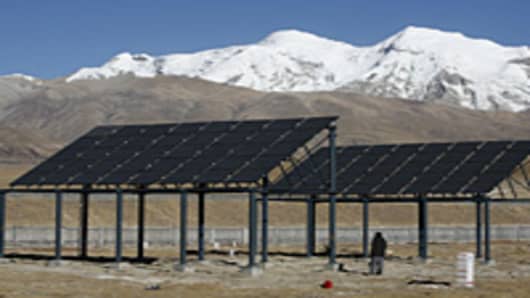In other words, this is not a charity. It’s not greenwashing. It’s a simple acknowledgment that Goldman sees big profits in solar, wind, and biomass power, not to mention the cheapest renewable energy of all, conservation.
While most investor attention has been focused on failed efforts, such as Solyndra, or political battles concerning feed-in tariffs and other aid, a new generation of gear is coming along that can do economic battle with fossil fuels without subsidy:
- The University of Chicago has a new cell-making process that’s as simple as soaking a substrate in a semiconductor solution and drying it. The new cells also use infrared energy, not just visible light, to produce electricity.
- The University of Texas has crafted an organic plastic semiconductor that could allow for plastic solar cells with double the efficiency of current “rare earth” systems.
- Semprius of North Carolina has demonstrated a cell with a 33 percent efficiency, again double what current systems offer.
- Swedish scientists are working on a catalyst that breaks water into oxygen and hydrogen efficiently enough for the hydrogen to be used as fuel.
- The Massachusetts Institute of Technology has developed a three-dimensional panel array that can handle far more panels, and harvest far more energy per square meter, than anything now on the market.
- The University of Tennessee is working on a “biosolar” system that uses the same system plants used to harvest energy, again saving enormously on materials costs.
There are so many dimensions on which the industry can save — materials cost, manufacturing cost, installation cost, channel cost — that increases in efficiency are really just icing on the cake. (Oh, and have you checked out the $999 plug-in solar panel at Amazon.com?)
While I mainly cover solar energy, there are breakthroughs happening across the space. The Goldman Sachs release mentions LED lighting, far more energy-efficient and longer-lasting than those “curly” fluorescent bulbs and coming down rapidly in price. (My Christmas lights are already LEDs.)
Engineers have found ways to drop the cost of wind power systems 20 percent over the last 10 years, making them competitive with grid electricity in many areas. Chevron and Exxon Mobil have both invested in algae fuels, which are already producing chemical by-products at prices competitive with oil-based manufacturing.
The point is that while Goldman Sachs is patting itself on the back, it’s really just pointing out what time it is. It’s sunrise for the renewable industries, and that could spell sunset for high-end oil plays.
—By TheStreet.com’s Dana Blankenhorn
Additional News: Why GE Believes in Hiring Our Heroes
Additional Views: Expect GE to Beat the Market Over Next Two Years: CIO
_____________________________
CNBC Data Pages:
______________________________
Disclosures:
TheStreet’s editorial policy prohibits staff editors, reporters, and analysts from holding positions in any individual stocks.
Disclaimer


